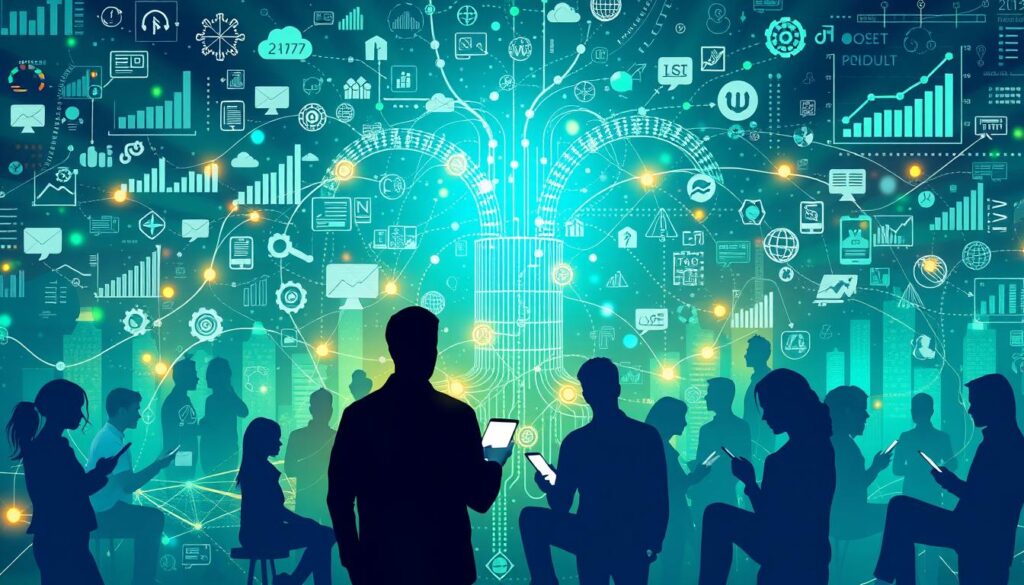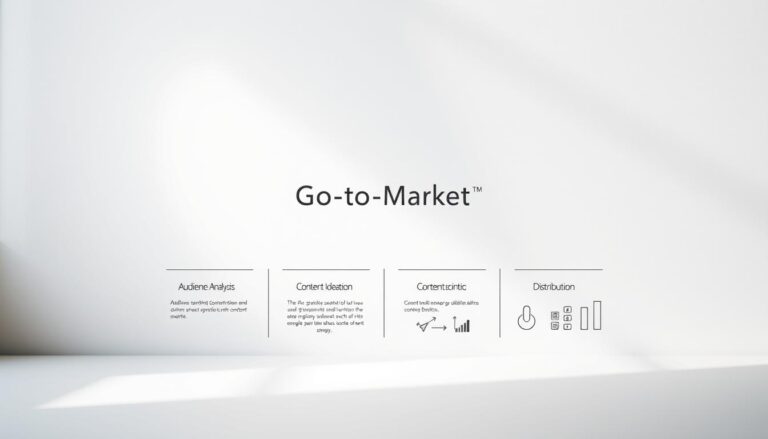The blend of high-tech marketing tools and sharp strategies has birthed ai-driven personalized marketing strategies. This approach utilizes the precision of AI to boost customer engagement. With the need for relevance and timing in the digital market, AI’s role in creating targeted campaigns is key. Studies show that personalized content directly increases sales and ROI. It speeds up the customer’s journey in the sales funnel and helps build strong, lasting relationships with them.
At the heart of effective marketing lies AI-driven personalization. It saves time and resources by automating content creation based on data insights. Integrating machine learning lets businesses predict consumer behavior and stay ahead in market trends. As AI grows, focusing on transparent data use and ethical AI is essential to keep trust.
Local digital marketing magnifies personalization by offering unique experiences to different market segments. Hiring a digital marketing agency brings the advantages of AI tools and budget flexibility. This avoids the high costs tied to developing in-house capabilities.
Key Takeaways
- Relevant content delivered through AI-driven strategies has proven to increase customer purchases and brand engagement.
- Efficient marketing automation powered by AI accelerates the conversion process, enhancing the overall customer journey.
- The utilisation of local agencies provides a nuanced approach to AI personalization strategy, anchored in regional insights.
- Ethical data handling is paramount; businesses must prioritize transparency and user consent in their AI applications.
- Regional digital marketing expertise reinforces tailored AI marketing techniques through informed local perspectives.
- AI is paving the way for future advancements in marketing personalization, with predictive analytics leading the charge.
Understanding AI in Marketing
Businesses these days need to keep up with tech-smart customers. AI-driven marketing is a key trend now. It uses artificial intelligence to make marketing more personal and effective. By getting how AI works in marketing, firms can better connect with customers, boosting engagement and loyalty.
What is AI-Driven Marketing?
AI-driven marketing means using AI to make marketing more personal and efficient. It uses machine learning to analyze data for better marketing automation. In short, AI helps brands craft personalized campaigns that change based on what users like and need.
Benefits of AI Technologies in Marketing
Adding AI to marketing helps in many ways, like improving customer experiences and making campaigns more effective. Some benefits include:
- Increased Personalization: AI helps businesses offer more relevant experiences by understanding customer preferences.
- Higher Conversion Rates: Personalization through AI improves targeting, boosting conversions and investment returns.
- Efficiency in Operations: AI takes over routine tasks, letting teams work on creative projects.
- Scalability: AI systems can manage loads of data and interactions, offering personalized service to many customers at once.
Companies like Amazon, Netflix, and Spotify already use AI for personalized recommendations and content. They are examples of great customer-focused service.
To use these advanced AI features while respecting privacy, companies must follow laws like GDPR and CCPA. They need clear privacy policies, manage user consents well, and audit data regularly among other things.
As AI technology gets better, it changes how marketing works. Marketers must keep up with new tech. They also need to make sure their use of AI reflects human values and ethics.
The Role of Data in Personalization
Data is key in today’s digital marketing world. It helps businesses make targeted marketing strategies that work really well. By using personalized marketing insights, companies can make their customers’ experiences better. They also see big improvements in their results.
Types of Data for Effective Personalization
To personalize marketing, you need good data. Important kinds include:
- User behaviors and interactions (e.g., website clicks, session duration)
- Transaction and purchase histories
- Social media activity and engagement levels
- Demographic information (age, gender, location)
- Psychographic details (interests, values, lifestyles)
This information lets marketers understand their audience better. It leads to personalized marketing insights. These insights increase engagement and sales.
Data Privacy Considerations
The more data you have, the more responsibly you must handle it. Businesses are doing a few key things:
- Following rules like GDPR to keep data safe and private
- Using clear methods to collect data
- Letting customers control their personal data
These steps keep trust high. They make sure data-driven marketing can keep going strong.
| Statistic | Detail |
|---|---|
| 53% of consumers | Very concerned about data security and breaches |
| 60% of consumers | Willing to share data for personalized experiences |
| 86% of CEOs | Consider personalization essential for customer experience |
| 71% of consumers | Expect personalized content from brands |
| 67% of customers | Frustrated when interactions are not personalized |
| 3x revenue growth | Achieved by companies prioritizing customer experience |
Using AI-driven customer segmentation and targeted marketing strategies well makes a big difference. It not only makes the customer’s experience better. It also gives businesses an edge in the market.

Customer Segmentation Techniques
Businesses are enhancing their marketing with AI-driven customer segmentation. This approach uses machine learning to dive deep into customer data. It uncovers customer preferences and behaviors that older methods might miss.
Behavioral Segmentation
Behavioral segmentation looks at what customers do, their purchase history, and how they interact online. AI and machine learning help companies predict future actions. This allows for marketing that feels personal, improving loyalty and customer experiences.
Demographic Segmentation
Demographic segmentation uses data like age, gender, and income. AI helps sort through the data, making sure messages fit the target group well. This method tailors marketing to match each demographic’s needs precisely.
Psychographic Segmentation
Psychographic segmentation explores people’s values, lifestyles, and attitudes. With AI-driven customer segmentation tools, marketers find what truly motivates purchases. Strategies can then align with individual values and preferences.
AI in customer segmentation means marketing that’s both personal and efficient. It leads to better engagement, more sales, and happier customers. It’s a new marketing era, merging personal touch with high efficiency.
- AI technology enhances precision and dynamism in customer segmentation.
- Machine learning enables predictive capabilities, forecasting future customer behaviors.
- Dynamic adaptation of segmentation strategies through real-time data processing.
Using machine learning marketing tactics transforms the marketing scene. It allows companies to build deeper connections with customers. This not only boosts efficiency but also strengthens loyalty and satisfaction.
Implementing AI-Driven Strategies
The adoption of AI-driven marketing strategies is changing how businesses connect with clients. It’s not just about picking tools and tech, but understanding the customer’s experience through data-driven insights.
Tools and Software for AI-Driven Marketing
Choosing the right tools is critical for marketers wanting personalized marketing automation. They use advanced machine learning to analyze loads of data. They can collect and analyze data, personalize content, adapt to user behavior in real-time, and communicate through chatbots and virtual assistants.
Some of the core technologies at the forefront include:
- Machine learning algorithms for predictive analytics and forecasting customer behavior.
- Natural language processing (NLP) tools for better customer interaction through intelligent chat solutions.
- Recommendation engines to customize content and offers based on user likes and past behavior.
By using these technologies, companies see Better customer involvement and growth in conversions and loyalty. They tailor interactions to an individual’s likes and needs.
Creating Customer Personas
To fully use AI-driven marketing strategies, it’s essential to create detailed customer personas. These personas help companies understand and divide their audience better. They use behavioral and demographic data to make their marketing more relevant.
Here are some examples of their success:
| Metrics | Impact |
|---|---|
| Conversion Rates | Higher conversion through personalized experiences |
| Customer Retention | Improved with tailored content making customers feel valued |
| Average Order Value | Increases via real-time product recommendations |
| Click-Through Rates (CTR) | Enhanced through relevant, targeted content |
For more on how this tech changes the game, check out brands like Coca-Cola and BMW’s success with AI in marketing.

In conclusion, using AI-driven strategies in marketing boosts customer involvement and business success. Despite challenges in scaling and data privacy, the right tools and clear personalization strategy can manage issues.
Analyzing AI-Based Campaigns
Digital marketing is changing fast, thanks to AI. It’s crucial to use AI to check if campaigns are working well. With personalized marketing insights and machine learning, marketers can make their plans sharper and more efficient.
AI is key in improving how campaigns are managed. It helps process data and predict results in real time. This leads to better marketing tactics that are directly aimed at the right customers.
Key Performance Indicators (KPIs)
Measuring the success of AI-powered campaigns needs focus on certain KPIs. Look at conversion rates, how many customers stick around, and click-through rates. These metrics show how well a campaign is doing.
The time guests spend on digital platforms also matters. It shows if the content is catching their attention.
A/B Testing and Optimization
A/B testing is vital for improving marketing plans. AI helps analyze big data sets quickly for this. Marketers can test different campaign elements to see what works best with their audience.
Using AI, they can predict how well a campaign will perform. This means they can fix things before going big, saving both time and resources.
Tools like Google Analytics 4, HubSpot, and Salesforce Einstein bring AI into marketing more. They help in analyzing data and fine-tuning marketing spend. This makes it easier for businesses to stay ahead, matching market trends and customer needs.
By using machine learning, companies can guess what customers want next. This makes every ad more likely to succeed. Each campaign builds on the last, making strategies smarter with data. And that’s where the future of marketing is heading.
Case Studies: Successful AI-Driven Campaigns
In today’s digital age, companies are using ai-driven marketing strategies to get ahead. They showcase their success with AI through vivid case studies. These stories highlight how data, machine learning, and personalized marketing automation are changing the game.
Retail Sector Examples
Big retail names are turning to AI to increase customer interest and sales. Take Starbucks, for example. They used AI to guess what customers might want next. This not only kept customers coming back but also boosted their app use and sales.
Sephora is another brand that used AI smartly by launching virtual try-ons. This cool feature helped boost their online sales by 30%. These examples show AI is more than a trend; it’s a key player in creating personalized shopping experiences.
B2B Insights
In the B2B world, AI’s impact is just as big, especially in finding and attracting leads. Heinz’s AI-driven social media campaign saw a 38% increase in engagement. It also made a massive splash globally with over 850 million impressions. This shows AI’s power in reaching more people and getting them interested.
Euroflorist used AI to make its website better for each visitor. By doing so, they saw more people not just visiting but also buying, thanks to a more personalized experience. This effort increased their conversion rates and customer happiness.
Below are examples of how certain brands have embraced AI in their marketing:
| Brand | Strategy | Outcome |
|---|---|---|
| Starbucks | AI-driven predictive analytics | Increased customer engagement and higher sales |
| Amazon | Dynamic pricing via AI | 35% boost in sales |
| Sephora | AI-enabled virtual try-ons | 30% rise in online sales |
| Heinz | AI-enhanced social media campaigns | 850 million impressions, 38% increase in engagement |
| Euroflorist | AI-driven massively multivariate testing | Enhanced website conversion rates |
Future Trends in AI Personalization
The landscape of artificial intelligence marketing solutions is changing fast. It’s changing how brands talk to people. Now, using data to personalize is a must-have, not just a nice-to-have. Industry pioneers are using AI to really understand what customers want. This has led to a 4% rise in earnings. Plus, there’s been an 80% drop in the work needed for client tasks.
The Rise of Hyper-Personalization
Hyper-personalization is at the cutting edge of marketing tech. AI helps focus on each person’s likes and needs. McKinsey reports that this kind of personal touch can boost sales by 5% to 15%. It can also make marketing efforts 10% to 30% more efficient. The future of marketing will use AI to customize every aspect of how businesses interact with customers. It means each interaction will be as unique as the person it’s meant for.
Predictive Analytics in Marketing
Predictive analytics in marketing is becoming really important. It lets companies predict things like sales and what customers might buy next. Giants like Netflix use it to suggest shows and movies you might like. Predictive analytics is expected to take off, with the conversational AI market hitting 18 billion USD by 2026. By using predictive analytics, businesses can improve customer satisfaction by 20%. They can also increase their earnings by up to 15% while cutting customer service costs by 20%.
FAQ
What is AI-Driven Marketing?
AI-driven marketing uses artificial intelligence to make campaigns better and more efficient. It involves AI tools that help anticipate customer needs, matching products and services to these needs. It also uses machine learning for complex tasks, improving decision-making in marketing.
What are the Benefits of AI Technologies in Marketing?
Key benefits include higher customer satisfaction and better engagement. AI helps in personalizing content, precisely segmenting customers, and anticipating their future needs. This leads to more adaptable marketing that changes with trends and user behavior.
What Types of Data are Used for Effective Personalization?
For personalization, marketers use data like user actions, buying histories, preferences, and interactions. This helps create experiences that truly match each customer’s interests.
How are Data Privacy Considerations Handled in Personalized Marketing?
Data privacy is crucial. Marketers must follow laws like the GDPR and ensure strong security. They must also be clear with customers about how data is used and ensure consent, keeping trust and transparency at the forefront.
What is Behavioral Segmentation?
Behavioral segmentation looks at customers’ actions with a brand. This includes what they buy, how they use a website, and responses to marketing. The aim is to tailor marketing to fit different customer behaviors and preferences.
What Does Demographic Segmentation Involve?
Demographic segmentation divides customers based on facts like age, gender, income, and job. It helps marketers craft campaigns that appeal to groups with similar characteristics.
How Does Psychographic Segmentation Work?
Psychographic segmentation digs into psychological aspects, like values and interests. It seeks to understand the reasons behind purchases and create messages that resonate on a deeper level.
What Tools and Software are Essential for AI-Driven Marketing?
AI marketing needs tools like machine learning algorithms, language processors, CRM systems, and recommendation engines. These help analyze data, automate tasks, personalize content, and interact with users more effectively.
How Important are Customer Personas in AI-Driven Marketing?
Very important. Customer personas help AI systems tailor content and offers, making campaigns more targeted and effective.
Which Key Performance Indicators (KPIs) are Important for Analyzing AI-Based Campaigns?
Look at conversion rates, customer retention, click-through rates, and average session duration. These KPIs gauge AI campaign success and guide improvements.
How Does A/B Testing and Optimization Benefit AI-Driven Marketing?
A/B testing lets marketers compare content and strategies to see what works best. This continuous improvement enhances marketing and the customer experience.
Can You Provide Some Retail Sector Examples of Successful AI-Driven Campaigns?
In retail, AI boosts conversion rates and order values with real-time product suggestions. Personalization has also increased sales by making offers more relevant to each customer.
What Insights Have Emerged from AI-Driven B2B Marketing?
AI in B2B marketing improves targeting and lead generation. It helps find and engage potential clients more effectively, boosting sales and acquiring new customers.
What is Hyper-Personalization and How is it Impacting Marketing?
Hyper-personalization uses data and technology for highly individualized marketing. It tailors experiences to each customer’s preferences and behaviors, creating uniquely relevant experiences.
How Will Predictive Analytics Shape the Future of Marketing?
Predictive analytics will let marketers forecast future consumer behaviors and trends. This will guide content, product development, and strategies, meeting consumer desires proactively.



